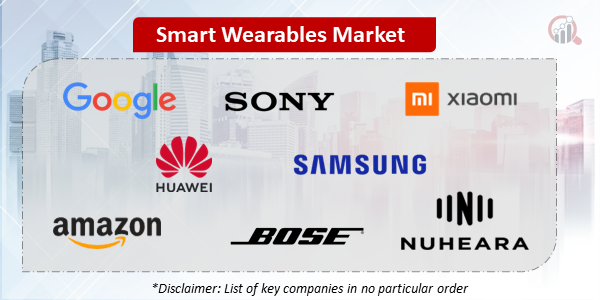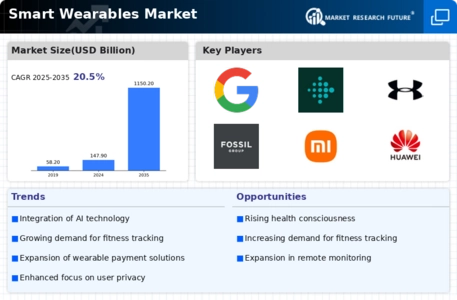Top Industry Leaders in the Smart Wearables Market

The Competitive Landscape of the Smart Wearables Market:
The smart wearables market, encompassing smartwatches, fitness trackers, hearables, and other tech-infused garments, is experiencing explosive growth. This dynamic space is characterized by fierce competition, with established players vying for market share alongside innovative newcomers. Understanding this landscape is crucial for any company seeking to navigate this thriving industry.
Key Players:
- Google LLC
- Sony Corporation
- Fossil Group
- Solos Technology Limited
- Xiaomi
- Huawei
- Garmin Ltd
- Samsung Electronics Co. Ltd.
- Amazon
- Fitbit
- Under Armour
- Bose
- Nuheara
- Starkey
- BBK Group
Strategies Adopted by Key Players:
-
Apple: Maintains a dominant position with its Apple Watch, leveraging brand loyalty, seamless integration with its ecosystem, and a focus on health and wellness features. -
Samsung: Offers a diverse portfolio of Galaxy smartwatches, catering to various budgets and preferences. Their focus on fitness tracking and integration with their Galaxy ecosystem helps them compete effectively. -
Fitbit: Remains a leader in fitness trackers, known for their user-friendly interface and comprehensive health monitoring features. They are expanding into smartwatches to broaden their appeal. -
Garmin: Holds a strong position in the sports and outdoor segment with advanced GPS and activity tracking features. Their focus on niche markets and partnerships with athletes solidifies their position.
Market Share Analysis:
Several key factors influence market share analysis in the smart wearables market:
-
Product Portfolio: Diversification across various device types (smartwatches, fitness trackers, hearables) and functionalities (health monitoring, communication, entertainment) is crucial. Leading companies like Apple and Samsung offer comprehensive portfolios, while niche players like Fitbit excel in specific areas. -
Technological Innovation: Continuous innovation in areas like miniaturization, battery efficiency, sensor technology, and integration with other platforms differentiates brands. Companies like Garmin, known for their advanced sports tracking, stand out in this regard. -
Brand Recognition and Marketing: Building a strong brand identity and effective marketing campaigns are vital. Apple, with its loyal user base and sleek marketing strategies, demonstrates this power. -
Pricing Strategies: Competitive pricing, often coupled with tiered product options, caters to diverse consumer segments. Xiaomi's budget-friendly smartwatches have garnered them a significant share. -
Distribution Channels: Reaching consumers through various channels, including online stores, physical retailers, and partnerships with telecom operators, expands market reach. Huawei, with its strong presence in China and partnerships with major carriers, leverages this advantage.
New and Emerging Players:
-
Amazfit: Offers affordable smartwatches and fitness trackers with a focus on battery life and health monitoring. Their growing product portfolio and international expansion strategy pose a challenge to established players. -
Huawei: Their Honor Band series and Huawei Watch line are gaining traction, particularly in Asia and Europe. They leverage competitive pricing and integration with their smartphone ecosystem. -
Noise: An Indian brand, Noise has seen significant growth with its budget-friendly smartwatches and fitness trackers. They cater to the price-sensitive segment, particularly in emerging markets. -
Smaller Startups: Numerous smaller players are innovating in niche areas like smart glasses, hearables, and health-focused wearables. They bring agility and fresh ideas to the market, potentially disrupting existing categories.
Industry Developments
Google LLC:
-
Focus on health and wellness: Google is increasingly integrating health and wellness features into its wearables, such as sleep tracking, heart rate monitoring, and stress detection. This aligns with the broader industry trend towards preventative healthcare and personalized fitness solutions. -
Integration with Fitbit: Following the acquisition of Fitbit in 2021, Google is working on integrating Fitbit's technology and user base into its Wear OS platform. This aims to create a more robust and competitive offering in the smartwatch market. -
Expansion into AR and VR wearables: Google is exploring the development of augmented reality (AR) and virtual reality (VR) wearables. This could potentially lead to new applications and experiences in areas like gaming, education, and productivity.
Latest Updates:
-
New Wear OS features: Google recently announced new features for Wear OS, including improved notification management, a new sleep tracking app, and expanded app support. -
Fitbit Sense 2 launch: Fitbit launched the Sense 2 smartwatch in September 2023, featuring advanced health tracking capabilities and stress management tools.
Sony Corporation:
-
Focus on gaming and entertainment: Sony's smart wearables primarily focus on gaming and entertainment applications, such as virtual reality headsets and fitness trackers integrated with gaming platforms. -
Exploration of AR and VR: Sony is actively involved in the development of AR and VR technologies, and its smart wearables could play a role in future AR/VR experiences. -
Collaboration with other companies: Sony is collaborating with other companies, such as Microsoft, on wearable technology development. This could lead to new and innovative products in the future.
Latest Updates:
-
New PlayStation VR2 headset: Sony launched the PlayStation VR2 headset in February 2024, offering advanced VR experiences for PlayStation 5 users. -
Mocopi motion capture system: Sony released the Mocopi motion capture system in October 2023, enabling users to capture their movements for various applications, including gaming and animation.









